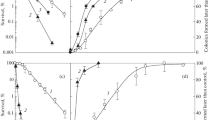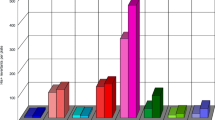Summary
Aminoacridines induce frameshift mutations and are photodynamically active, depending on whether visible light is absent or present. Therefore, a test system which allows to compare quantitatively the genetic effects of aminoacridines irradiated or unirradiated by visible light ought to be susceptible to the different DNA alterations which can be induced by these substances. For this reason in most experiments mitotic gene conversion and only in some selected experiments reverse mutation was chosen as the indicator of genetic activity. In contrast to mutation systems mitotic gene conversion has never shown a response specific to only some types of mutagens.
The three aminoacridine derivatives used-acridine orange (AO), proflavine (PF), and acridine yellow (AY)—were successful in the induction of convertants at two different loci. No locus-specificity could be observed. The time-dependent induction of convertants proceeds quickly but soon reaches—especially after treatment without light—a saturation point. The dose/effect-curve after treatment in the dark has a slope increasing with increasing concentration. Irradiation with visible light results in a dose/effect-curve consisting of three parts. At first the increase of convertants is nearly linear extending one (AY) to three (AO) orders of magnitude. After that a saturation effect begins at the point at which an effectiveness of the acridines in the dark is apparent. At high concentrations an induction of convertants can again be observed which is nearly the same as that after treatment in the dark.
To determine whether the dose/effect-curves obtained for gene conversion refer to similar curves for gene mutations after treatment with AO at the same locus not only gene conversions but also reverse mutations were scored for.
AO-treatment in the dark is ineffective in inducing reverse mutations. Irradiation with visible light results in a dose/effect-curve beeing parallel only in its first part to the dose/effect-curve obtained for gene conversion, while in its second part a mutation frequency decline can be observed.
Comparing the dose/effect-curves of AO resulting from the induction of gene conversion and gene mutation, and taking into account that no mutants can be induced by AO-treatment in the dark, the increase in convertants at high acridine-concentrations can be explained as an addition of light-dependent and light-independent effects. That means, in mutation systems at low concentrations of aminoacridines irradiation with visible light should cause transitions, transversions and microlesions, at intermediate concentrations frameshift lesions should begin to appear, and at very high concentrations nearly exclusively frameshift lesions should occur.
The dose/effect-curves of aminoacridines compared with those of other mutagens are very complex. The dose/effect-curves of the mutagens of other type of action tested are linear in a double logarithmic scale, and parallel for induced gene conversion and induced gene mutation. These results indicate that the gene conversion ability of a given compound depends on its mutagenic property. That means, many mutagens may exert specific genetic effects not directly but mainly in indirect ways by leading to DNA damage, a situation for repair synthesis resulting as well in mutations as recombinations.
Similar content being viewed by others
References
Armstrong, R.W., Kurucsev, T., Strauss, U.P.: The interaction between acridine dyes and deoxyribonucleic acid. J. Amer. chem. Soc.92, 3174–3181 (1970)
Ball, C., Roper, J.A.: Studies on the inhibition and mutation of Aspergillus nidulans by acridines. Genet. Res.7, 207–221 (1966)
Barricelli, N.A., Del Zoppo, G.: Genotypic reversion by methylene blue: The orientation of guanine-hydromethyl-cytosine at mutated sites in r II mutants of phage T 4. Molec. gen. Genet.101, 51–58 (1968)
Bradley, D.F., Wolf, M.K.: Aggregation of dyes bound to polyanions. Proc. nat. Acad. Sci. (Wash.)45, 944–952 (1959)
Brendel, M.: Induction of mutation in phage T 4 by extracellular treatment with methylene blue and visible light. Molec. gen. Genet.101, 111–115 (1968)
Brenner, S., Barnett, L., Crick, F.H.C., Orgel, A.: The theory of mutagenesis. J. molec. Biol.3, 121–124 (1961)
Davies, P.J., Evans, W.E., Parry, J.M.: Mitotic recombination induced by chemical and physical agents in the yeast Saccharomyces cerevisiae. Mutation Res.29, 301–314 (1975)
Delmelle, M., Duchesne, J.: Effect of light on dyes and photodynamic action on biomolecules. In: Pullmann, B., ed., p. 299. New York: Academic Press 1968
Drake, J.W.: Heteroduplex heterozygotes in bacteriophage T 4 involving mutations of various dimensions. J. cell. comp. Physiol.64, Suppl. 1, 19–31 (1964)
Drake, J.W.: The molecular basis of mutation. San Francisco: Holden-Day 1970
Drake, J.W., MacGuire, J.: Properties of r mutants of bacteriophage T 4 photodynamically induced in the presence of thiopyronin and psoralen. J. Virol1, 260–267 (1967)
Drummond, D.S., Simpson-Gildemeister, V.F.W., Peacocke, A.R.: Interaction of aminoacridines with deoxyribonucleic acid: effects of ionic strength, denaturation, and structure. Biopolymers3, 135–153 (1965)
Dulbecco, R., Vogt, M.: Studies on the induction of mutations in poliovirus by proflavin. Virology5, 236–243 (1958)
Fahrig, R.: Acridine-induced mitotic gene conversion (paramutation) in Saccharomyces cerevisiae: the effect of two different modes of binding to DNA. Mutation Res.10, 509–514 (1970)
Fahrig, R.: Nachweis einer genetischen Wirkung von Organophosphor-Insektiziden. Naturwissenschaften60, 50–51 (1973)
Freifelder, D., Davison, P.F., Geiduschek, E.P.: Damage by visible light to the acridine orange-DNA complex. Biophys. J.1, 389–400 (1961)
Gräslund, A., Rigler, R., Ehrenberg, A.: Light induced free radicals in DNA-acridine complexes studied by ESR. FEBS Letters4, 227–230 (1969)
Holliday, R.: A mechanism for gene conversion in fungi. Genet. Res.5, 282–304 (1964)
Holliday, R.: Altered recombination frequencies in radiation sensitive strains of Ustilago. Mutation Res.4, 275–288 (1967)
Hurwitz, J., Furth, J.J., Malamy, M., Alexander, M.: The role of deoxyribonucleic acid in ribonucleic acid synthesis, III. The inhibition of the enzymatic synthesis of ribonucleic acid and deoxyribonucleic acid by actinomycin D and proflavin. Proc. nat. Acad. Sci. (Wash.)48, 1222–1230 (1962)
Imray, P., MacPhee, D.G.: Induction of frameshifts and basepair substitutions by acridine orange plus visible light in bacteria. Mutation Res.20, 433–435 (1973)
Kohno, T., Roth, J.R.: Proflavin mutagenesis of bacteria. J. molec. Biol.89, 17–32 (1974)
Lerman, L.S.: The structure of the DNA-acridine complex. Proc. nat. Acad. Sci. (Wash.)49, 94–102 (1963)
Lerman, L.S.: Acridine mutagens and DNA structure. J. cell. comp. Physiol. 64, Suppl.1, 1–18 (1964)
Magni, G.E., von Borstel, R.C., Sora, S.: Mutagenic action during meiosis and antimutagenic action during mitosis by 5-aminoacridine in yeast. Mutation Res1, 227–230 (1964)
Malling, H.V., De Serres, F.J.: Mutagenicity of alkylating carcinogens. Ann. N.Y. Acad. Sci.163, 788–800 (1969)
Manney, R.T., Mortimer, R.K.: Allelic mapping in yeast by X-ray-induced mitotic reversion. Science143, 581–583 (1964)
Mohn, G.: 5-Methyltryptophan resistance mutations in Escherichia coli K-12. Mutagenic activity of monofunctional alkylating agents including organophosphorus insecticides. Mutation Res.20, 7–15 (1973)
Nakai, S., Saeki, T.: Induction of mutation by photodynamic action in Escherichia coli. Genet. Res.5, 158–161 (1964)
Orgel, A., Brenner, S.: Mutagenesis of bacteriophage T 4 by acridines. J. molec. Biol.3, 762–768 (1961)
Peacocke, A.R., Skerrett, J.N.H.: The interaction of aminoacridines with nucleic acids. Trans. Faraday Soc52, 261–279 (1956)
Ritchie, D.A.: Mutagenesis with light and proflavin in phage T 4 Genet. Res.5, 168–169 (1964)
Ritchie, D.A.: Mutagenesis with light and proflavin in phage T 4, 2. Properties of the mutants. Genet. Res.6, 474–478 (1965)
Roman, H., Jacob, F.: Effect de la lumière ultraviolette sur la recombinaison gènètique entre allèles chez la levure. C. R. Acad. Sci. (Paris)245, 1032–1034 (1957)
Sarabhai, A., Lamfrom, H.: Mechanism of proflavin mutagenesis. Proc. nat. Acad. Sci. (Wash.)63, 1196–1197 (1969)
Simon, M.J., Van Vunakis, H.: The photodynamic reaction of methylene blue with deoxyribonucleic acid. J. molec. Biol.4, 488–499 (1962)
Stewart, C.R.: Mutagenesis by acridine yellow in Bacillus subtilis. Genetics59, 23–31 (1968)
Streisinger, G., Okada, Y., Emrich, J., Newton, J., Tsugita, A., Terzaghi, E., Inouye, M.: Frameshift mutations and the genetic code. Cold Spr. Harb. Symp. quant. Biol.31, 77–84 (1966)
Sussenbach, J.S., Berends, W.: Photodynamic degradation of guanine. Biochim. biophys. Acta (Amst.)95, 184–185 (1965)
Wacker, A., Turek, G., Gestenberger, A.: Zum Wirkungsmechanismus photodynamischer Farbstoffe. Naturwissenschaften50, 377 (1963)
Webb, R.B., Kubitschek, H.E.: Mutagenic and antimutagenic effects of acridine orange in Escherichia coli. Biochem. biophys. Res. Commun.13, 90–94 (1963)
Whitehouse, H.L.K., Hastings, P.J.: The analysis of genetic recombination on the polaron hybrid DNA model. Genet. Res.6, 27–92 (1965)
Wickerham, L.J.: A critical evaluation of the nitrogen assimilation test commonly used in the classification of yeast. J. Bact.52, 293–301 (1964)
Witkin, E.M.: Mutations in Escherichia coli induced by chemical agents. Cold Spr Harb. Symp. quant. Biol.12, 256–269 (1947)
Witkin, E.M.: The effect of acriflavin on photoreversal of lethal and mutagenic damage produced in bacteria by ultraviolet light. Proc. nat. Acad. Sci. (Wash)50, 425–430 (1963)
Zampieri, A., Greenberg, J.: Mutagenesis by acridine orange and proflavin in Escherichia coli strain S. Mutation Res.2, 552–556 (1965)
Zimmermann, F.K.: Induction of mitotic gene conversion by mutagens. Mutation Res.11, 327–337 (1971)
Zimmermann, F.K., Schwaier, R.: Induction of mitotic gene conversion with nitrous acid, 1-methyl-3-nitro-1-nitroso-guanidine and other alkylating agents in Saccharomyces cerevisiae. Molec. gen. Genet.100, 63–76 (1967)
Author information
Authors and Affiliations
Additional information
Communicated by F. Kaudewitz
Rights and permissions
About this article
Cite this article
Fahrig, R. The effect of dose and time on the induction of genetic alterations insaccharomyces cerevisiae by aminoacridines in the presence and absence of visible light irradiation in comparison with the dose-effect-curves of mutagens with other type of action. Molec. Gen. Genet. 144, 131–140 (1976). https://doi.org/10.1007/BF02428101
Received:
Issue Date:
DOI: https://doi.org/10.1007/BF02428101




